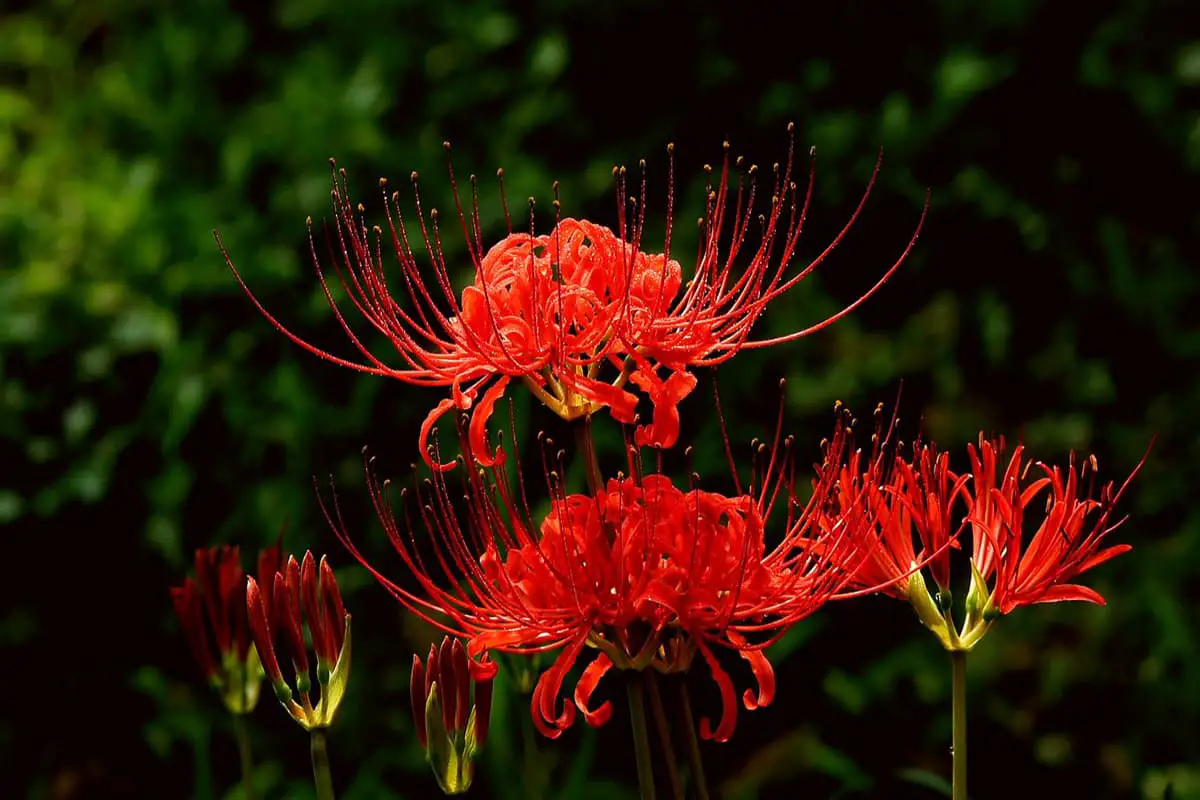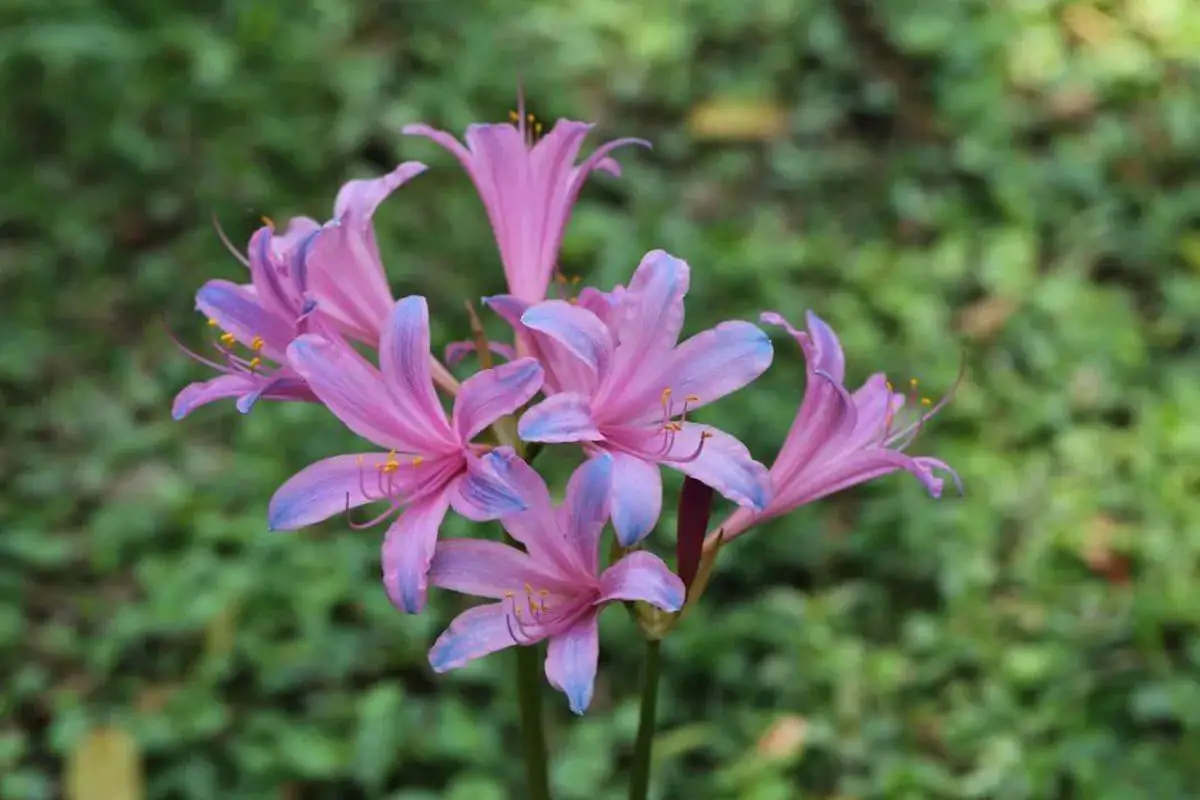The Lycoris radiata, commonly known as the red spider lily or hurricane lily, is a striking and culturally significant plant native to East Asia. This perennial bulbous herb belongs to the Amaryllidaceae family and is renowned for its unique growth cycle and vibrant red flowers.

The red spider lily grows from a nearly spherical bulb, typically 2-5 centimeters in diameter. Its leaves, which emerge in autumn after the flowers have faded, are narrow and strap-like, measuring about 30-40 centimeters long and 0.5-1 centimeter wide. These leaves are a deep green color with a distinctive pale green midrib running along their length. They persist through winter and wither in late spring.
The flower stem, known as a scape, emerges in late summer to early autumn and stands approximately 50-70 centimeters tall. At its apex, it bears two papery, lanceolate bracts that are about 3-5 centimeters long. The inflorescence is an umbel, typically consisting of 4-7 (occasionally up to 8) striking bright red flowers.

Each flower of the Lycoris radiata is unique in its structure. The perianth segments, which are often mistaken for petals, are narrowly oblanceolate, measuring about 5-7 centimeters long and 0.5-1 centimeter wide. These segments are strongly recurved, giving the flower its distinctive spider-like appearance. The color of the flowers ranges from vivid scarlet to deep crimson, sometimes with a slight orange tinge.
One of the most notable features of the red spider lily is its long, prominent stamens. These extend well beyond the perianth, often reaching twice its length, adding to the plant’s spider-like aesthetic. The style is equally long, ending in a small stigma.
The flowering period typically spans from August to October, depending on the specific climate and location. After pollination, the plant produces small, fleshy capsules containing seeds, which ripen in late autumn.
Lycoris radiata is native to China, Korea, and Nepal, but it has been widely cultivated and naturalized in many parts of East Asia, including Japan. In its natural habitat, the red spider lily thrives in areas with partial shade to full sun exposure. It is commonly found growing on moist, well-drained slopes, in woodland margins, and along stream banks.
In cultivation, the plant has shown remarkable adaptability. It is frequently grown in gardens, parks, and courtyards across its native range and beyond. The red spider lily has gained popularity in many temperate regions around the world, where it is valued for its unique bloom time and low maintenance requirements.
The plant’s ability to thrive in various soil types, from slightly acidic to neutral pH, contributes to its widespread cultivation. However, it performs best in rich, well-draining soils with consistent moisture during its growing season.
The Lycoris radiata var. radiata, commonly known as the wild red spider lily, thrives in shaded, moist environments. It demonstrates excellent adaptability to various soil types, with a particular affinity for red clay soils. This preference indicates its robust cold tolerance and ability to withstand daily average temperatures up to 24°C (75°F).
While the red spider lily prefers consistent moisture, it also exhibits remarkable drought tolerance. The ideal soil conditions for optimal growth are slightly acidic (pH 6.0-7.0), loose, fertile, and rich in organic matter. However, the plant’s adaptability allows it to grow in less ideal conditions as well.
One of the unique characteristics of Lycoris radiata is its summer dormancy period, which contributes to its resilience in various climates. Its high adaptability and cold resistance make it suitable for cultivation in diverse geographical regions.
In its natural habitat, the red spider lily often flourishes in locations that offer a balance of shade and moisture with good drainage. Common wild growth sites include:
These natural environments provide the combination of partial shade, moisture retention, and adequate drainage that the red spider lily prefers.
The red spider lily can be propagated through several methods, each with its own advantages and timeframes for flowering. The primary propagation techniques include:
Bulb division is the most common and efficient method for propagating red spider lilies. This technique is best performed during the plant’s dormant period or immediately after flowering. The process involves:
Bulbs propagated through this method typically flower within one to two years, making it the fastest way to produce blooming plants.
This method involves segmenting the bulb to encourage new growth:
After approximately three months, adventitious buds will form at the junction of the scales and the base. These will develop into small bulblets, which can be separately cultivated into new plants.
Tissue culture is a more advanced propagation technique used primarily in commercial or research settings:
Alternatively, flower stems and bulb scales with attached stem tissue can be used as explant materials to produce adventitious buds and bulbils.
Seed propagation is generally reserved for hybrid breeding purposes due to its longer time to maturity. Key points for this method include:
While seed propagation is the slowest method, it is crucial for developing new varieties and maintaining genetic diversity in breeding programs.
Each of these propagation methods has its place in both commercial production and hobbyist cultivation of red spider lilies, allowing for flexibility in plant multiplication and breeding efforts.
Prevention and control: Prior to planting, soak bulbs in a 0.3% copper sulfate solution for 30 minutes. Rinse thoroughly, allow to dry, then plant. For ongoing prevention, apply a 500:1 dilution of 50% Carbendazim every two weeks. If early signs of infection appear, treat with a 2500:1 dilution of 50% Benomyl (Benlate).
Larvae primarily damage leaves, buds, and fruits by consuming leaf tissue and boring into flower stems and seed pods. Activity typically occurs from late spring through November.
Prevention and control: Apply a preventative spray using a 2500:1 dilution of 5% Fipronil (Regent) suspension alternated with a 1000:1 dilution of Deltamethrin (Decis).
Larvae burrow into plants, often hollowing leaves and penetrating bulbs. Infested areas are characterized by substantial green or brown frass. Regularly inspect leaf undersides for neatly arranged egg clusters and remove immediately upon discovery.
Preventative measures include winter or early spring cultivation to expose and eliminate overwintering pupae.
For active infestations, apply a 1500:1 dilution of Lespedeza-based insecticide or an 800:1 dilution of petroleum oil emulsion. Treatment is most effective when applied in early morning or evening when larvae are actively feeding.
These tiny red insects primarily infest bulb leaf emergence sites, causing leaf discoloration through their feeding activity. Populations often increase after fruit ripening.
Prevention and control: Alternate applications of a 3000:1 dilution of 25% Imidacloprid with a 6000-10000:1 dilution of 70% Ameifen (Abamectin) for effective prevention.
Chafer grubs encompass the larval stage of various beetles in the Scarabaeoidea superfamily. These soil-dwelling larvae feed on newly sown seeds, roots, tubers, stems, and seedlings, resulting in plant loss and disrupted crop rows.
As widespread and damaging pests, immediate treatment with insecticides such as Endosulfan (Thiodan) or Trichlorfon (Dipterex) is recommended upon detection.
Lycoris species are prized ornamental plants in East Asia, valued for their foliage in winter and flowers in autumn. These excellent perennial herbaceous plants are often utilized in gardens for shade or as groundcover.
They are well-suited for naturalistic plantings in flower beds or rock gardens. As Lycoris blooms during its sparse-leaved phase, it pairs well with other shade-tolerant herbaceous plants. It’s an ideal choice for flower beds, border plantings, and makes a striking cut flower.
Lycoris bulbs contain over ten types of alkaloids, including lycorine, pseudolycorine, narcissine, lycoramine, and galanthamine. These compounds exhibit detoxifying, expectorant, diuretic, emetic, and insecticidal properties, though they are mildly toxic.
Traditionally used to treat sore throat, abscesses, scrofula, nephritis-related edema, and snake bites. Lycorine demonstrates potential anti-cancer properties and possesses anti-inflammatory, antipyretic, sedative, and emetic effects. Galanthamine and lycoramine are crucial in treating infantile paralysis.
Lycoris bulb properties: Pungent and warm in nature. Mildly toxic. Functions include detoxification, expectoration, diuresis, and emesis. Indications include sore throat, edema, urinary dysfunction, abscesses, scrofula, cough, asthma, and food poisoning.